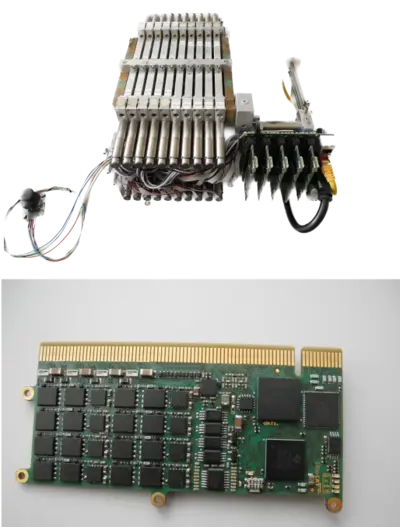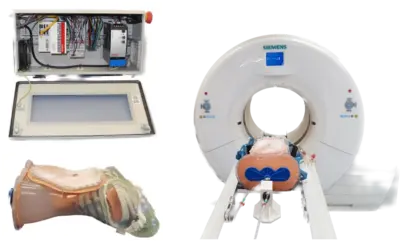Electronic & Embedded Systems Development Lab
Motivation
The "Electronics & Embedded Systems" working group is a service group for the DKFZ's research focus “Imaging and Radiation Oncology”. We provide the link to different scientific groups to realize technical projects. Our expertise lies in system architecture and design of electro-mechanical systems, real-time capable embedded and control systems, such as PLC and FPGA solutions, PLC design and medical engineering.
Research Topics
- BMBF VIP+ - High dynamic MLC control system
- EKFS (Else Kröner Fresenius Stiftung) - Anthropomorphic 4D Phantom
- Real-time controlled shutter for FLASH RT

Development of a new type of leaf and drive concept for multi-leaf collimators (MLCs) with lower weight and reduced complexity, as well as superior positioning speed and precision by realizing a dynamic real-time controlled leaves of an MLC to compensate for organ movements and achieve more precise tumor irradiation. The novel system architecture with real-time requirements allows reduction of control components in the radioactive environment of the radiation source to ensure higher reliability and allows dynamic real-time control of the leaves of an MLC to compensate for organ movements and achieve more precise tumor irradiation, which would optimally support the requirements of image-guided radiotherapy, such as e.g. MR-Linac systems.
This project was a joint project between the DKFZ and the Fraunhofer Institute PAMB in Mannheim and built an exemplary prototype as a proof-of-concept. Our working group assumed the role of project coordinator and implemented the project according to the project plan.
A demonstration of the project can be found here.

Development and validation of a novel anthropomorphic 4D-phantom that has X-ray scattering and absorption properties that are largely equivalent to properties that are largely equivalent to human tissue, reproduces internal organs in 3D, can simulate organ movements, such as coughing, swallowing, breathing and deform realistically, and can also transfer dependent disturbance variables to organ composites to organ systems.
Deformation and movement of synthetic organs and organ composites in all degrees of freedom are dynamically controlled in real-time. Disturbance variables, e.g. breathing, swallowing, coughing can be simulated and verify the effectiveness of adaptive irradiation methods.
The development allows an efficient end-to-end test for the verification of the entire radiotherapy chain and the dosimetric evaluation of the radiation plans.
More information here.
FLASH radiotherapy (RT) is a technique in which ultra-high dose rate radiation is applied to the target. FLASH RT has been shown to reduce radiation-induced toxicity in healthy tissue compared to conventional radiotherapy without compromising the anticancer effect of the treatment. Current preclinical experience is mainly based on FLASH electrons and the clinical application of FLASH-RT is very limited.
The incorporation of FLASH-RT into routine clinical radiotherapy requires the development of devices capable of generating FLASH photon beams.
A radiotherapy shutter is a device used to control the delivery of radiation during treatment. It can be used to shape and modulate the radiation beam, enabling precise targeting of the tumor and protection of the surrounding healthy tissue. The shutter is dynamically controlled in real-time and provides capability of adjustable exposure times <100ms.
Patents
| Number | Description |
|---|---|
| P-959 | WO2012123093A1 Position sensoring method and system for a multi-leaf collimator |
| P-973 | WO2012156389A1·Leaf module for a multi-leaf collimator and multi-leaf collimator |
| P-996 | WO2013014260A1 Therapeutic device for treating a predefined body part of a patient with rays |
| P-1044 | WO2014147046A1 Contour collimator for radiotherapy |
| P-1365 | WO2019197440A1 Control device for controlling at least one collimator |
| P-1536 | WO2022117790A1 Test system for testing a system for radiologic treatment |
Contact
-
Steffen Seeber
-
Carlos Murillo
